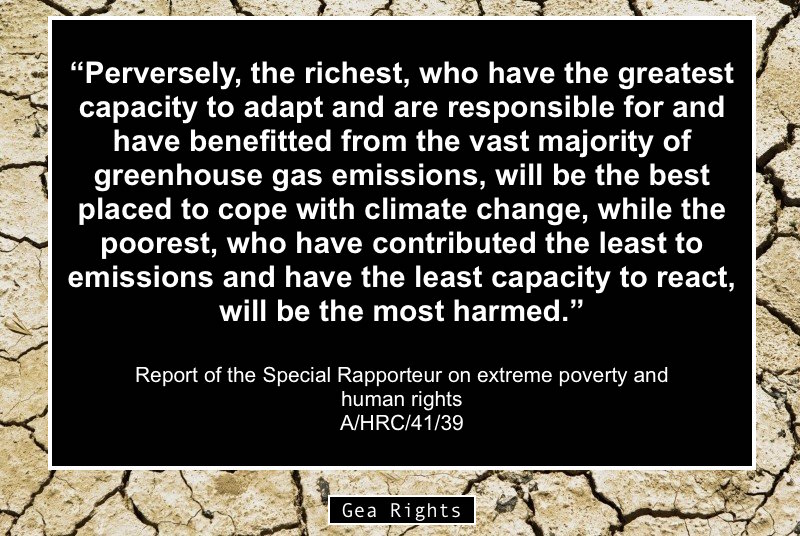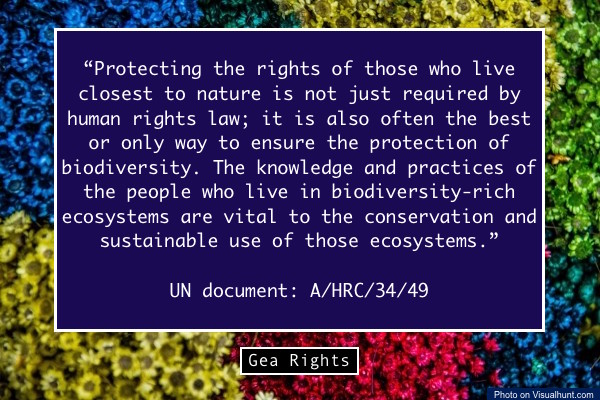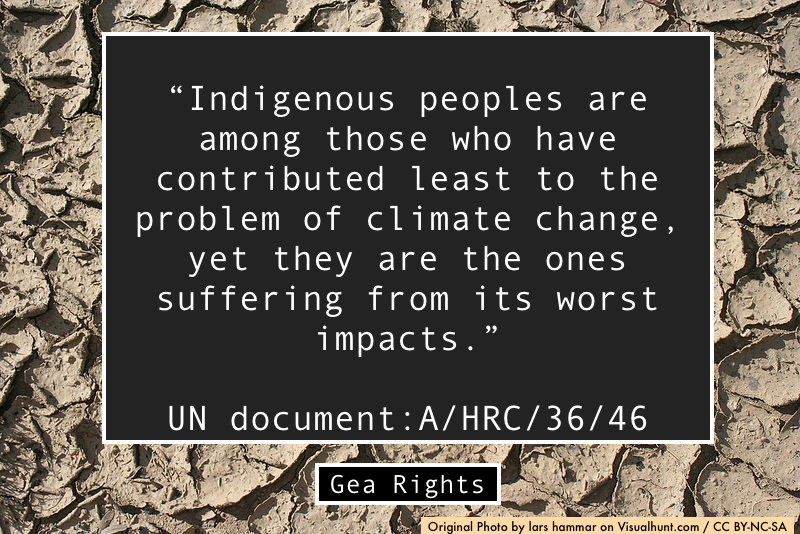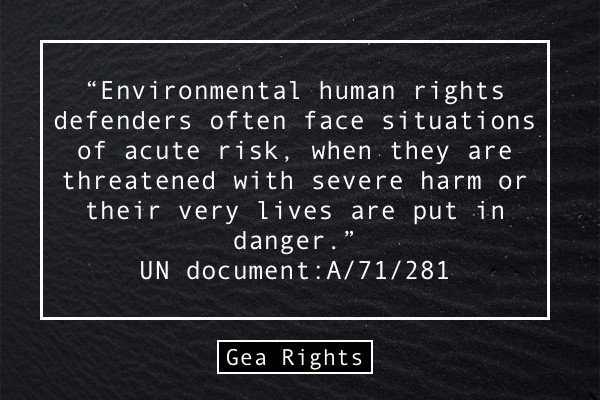The 1972 Stockholm Declaration of the UN Conference on Human Environment states in its first article:
“1. Man is both creature and moulder of his environment, which gives him physical sustenance and affords him the opportunity for intellectual, moral, social and spiritual growth. In the long and tortuous evolution of the human race on this planet a stage has been reached when, through the rapid acceleration of science and technology, man has acquired the power to transform his environment in countless ways and on an unprecedented scale. Both aspects of man’s environment, the natural and the man-made, are essential to his well-being and to the enjoyment of basic human rights the right to life itself.”(1)
According to Kotzé & French, the Stockholm Conference has represented “a catalyst” in the development of present International Environmental Law (IEL).(2) The authors argue that the Declaration is profoundly embedded in a “masculinist ontology of anthropocentrism”,(3) and that underlying theory, or ethos, of the Conference was that the environment, belonging exclusively to humans, had to be protected solely for ensuring their well-being, prosperity and health.(4)
The concept of sustainable development, a central paradigm in IEL, was first enounced in the 1987 Brundtland Report as the humans’ability “to make development sustainable to ensure that it meets the needs of the present without compromising the ability of future generations to meet their own needs”. (5) According to this definition, sustainable development puts humanity and its needs at the center of the environmental protection. The 1992 Rio Declaration reaffirmed in Principle 1 that “Human beings are at the centre of concerns for sustainable development”, and along with Principle 3, stating a “right to development” to be achieved respecting the “developmental needs of future generations”, reiterates an anthropocentric approach that sees conservation as a tool aimed at ensuring the humans’ welfare.(6) The Johannesburg Declaration follows the same approach, as shown also by the reinforcement of the sustainable development notion.(7)
The document “The Future We Want”, an outcome of Rio +20 Conference, still remains embedded in the concept of sustainable development, from an anthropocentric perspective that puts people “at the centre of sustainable development.”(8) However, it is important to note a short reference to the concept of harmony with nature, to the recognition of the rights of nature and to cultural diversity:
“39. We recognize that planet Earth and its ecosystems are our home and that ‘Mother Earth’ is a common expression in a number of countries and regions, and we note that some countries recognize the rights of nature in the context of the promotion of sustainable development. We are convinced that in order to achieve a just balance among the economic, social and environmental needs of present and future generations, it is necessary to promote harmony with nature.
40. We call for holistic and integrated approaches to sustainable development that will guide humanity to live in harmony with nature and lead to efforts to restore the health and integrity of the Earth’s ecosystem.” (9)
It is apparent how the rather short reference to the rights of nature is not intended to stimulate any similar action on an international level, while the reference to “holistic and integrated approaches” is balanced, and somehow diminished, by the reference to sustainable development immediately after. In the document there are also several references to the role of Indigenous Peoples, although always within the paradigm of sustainable development.(10)
According to Kotzé and French, the World Charter for Nature, adopted in 1982 and ignored in the mainstream environmental discourse, eclipsed by the Rio Declaration, is the only example of an eco-centric soft-law instrument “to counter the growth-without-limits developmental agenda” reflected in IEL.(11) The Charter asserts that “Mankind is a part of nature and life depends on the uninterrupted functioning of natural systems which ensure the supply of energy and nutrients”, and that:
“Civilization is rooted in nature, which has shaped human culture and influenced all artistic and scientific achievements, and living in harmony with nature gives man the best opportunities for the development of his creativity, and for rest and recreation.” (12)
The Charter also states that:
“Every form of life is unique, warranting respect regardless of its worth to man, and, to accord other organisms such recognition, man must be guided by a moral code of action.” (13)
However, in other parts of the Charter, a more anthropocentric perspective still emerges, like in Paragraphs 6 and 8:
“6. In the decision-making process it shall be recognized that man’s needs can be met only by ensuring the proper functioning of natural systems and by respecting the principles set forth in the present Charter.
“8. In formulating long-term plans for economic development, population growth and the improvement of standards of living, due account shall be taken of the long-term capacity of natural systems to ensure the subsistence and settlement of the populations concerned, recognizing that this capacity may be enhanced through science and technology.” (14)
Moving from soft law to the realm of the Multilateral Environmental Agreements (MEAs), the analysis of the most relevant treaties show the persistence of the anthropocentric approach in the relationship with nature and the paradigm centered on (sustainable) development. (15)
The Convention on Biological Diversity of 1992 (CBD), the Convention on International Trade in Endangered Species of Wild Fauna and Flora of 1973 (CITES), the Convention on Wetlands of International Importance of 1971 (RAMSAR) follow the same pattern. Although in their preambles they recognize respectively “the intrinsic value of biological diversity”,(16) or that “wild fauna and flora in their many beautiful and varied forms are an irreplaceable part of the natural systems of the earth”(17) or “the interdependence of Man and his environment”,(18) they always treat Nature as a resource functional to the achievement of human interests, development and survival, from an anthropocentric and utilitarian perspective that ignores the protection of the integrity of the Earth system.(19)
The Paris Agreement, adopted after the beginning of the Harmony with Nature Programme and the establishment of the Mother Earth day, contains in its Preamble a statement on this regard:
“Noting the importance of ensuring the integrity of all ecosystems, including oceans, and the protection of biodiversity, recognized by some cultures as Mother Earth, and noting the importance for some of the concept of ‘climate justice’, when taking action to address climate change”.(20)
In Article 2(1), however, the treaty affirms the commitment to “strengthen the global response to the threat of climate change, in the context of sustainable development and efforts to eradicate poverty”.(21) The Paris Agreement follows the same paradigm of the previous MEAs, as no particular changes can be noted in the approach adopted in the treaty, that continues to be anthropocentric and focused on sustainable development. According to Almiron & Tafalla, the scepticism and inaction surrounding climate change mostly depends on the dominant ethics and on the anthropocentric view, that in the Western economies in particular has caused what the authors define as the ideological denial.(22) This is reflected also in the terms used in mainstream communication to describe the phenomenon, climate change, that has often been preferred over more alarming concepts, such as global warming.(23) The authors note that denial is not only functional to the maintenance of the status quo and the privilege of the elites who deny the phenomenon, but also to the privilege of the generality of people living in rich, industrialized countries.(24) With their scepticism or inaction, in fact, they perpetuate “the capitalist status quo to protect their (to varying degrees) privileged position within it”, that guarantees their comfortable, high-carbon lifestyles.(25)
The analysis of the soft law and MEAs shows that IEL is characterized by an anthropocentric approach, focused on the needs of humans and on the conception of the natural environment as a set of resources to be preserved in order to ensure the sustainable development of present and future human generations.
Although since 2009 the UN has started the Programme Harmony with Nature to discuss a holistic, Earth-centered cosmovision, acknowledged in the legislation of several Member States and mainly rooted in the culture of Indigenous Peoples, this approach seems to find a very narrow space in IEL. The rights of Nature, in particular, do not seem to find space in IEL.
Footnotes:
(1) Stockholm Declaration of the United Nations Conference on the Human Environment, 1972
(2) Luis J. Kotzé, Duncan French, “The Anthropocentric Ontology of International Environmental Law and the Sustainable Development Goals: Towards an Ecocentric Rule of Law in the Anthropocene”, in Global Journal of Comparative Law, Vol. 7 (2018), p. 18
(3) Ibid.
(4) Ibid.
(5) Report of the World Commission on Environment and Development: Our Common Future, para 27, available at https://sustainabledevelopment.un.org/content/documents/5987our-common-future.pdf (accessed 20 June 2020)
(6) Luis J. Kotzé, Duncan French, “The Anthropocentric Ontology of International Environmental Law and the Sustainable Development Goals: Towards an Ecocentric Rule of Law in the Anthropocene”, op. cit., p. 19. As exemplified by the authors “We conserve, because we need to survive, and where we do not conserve sufficiently for our own survival, we are clever enough to develop the technologies to help us survive.”
(7) Ibid. p. 20
(8) UNGA Resolution A/RES/66/288 “The Future We Want”, para 6 available at https://sustainabledevelopment.un.org/futurewewant.html (accessed 20 June 2020)
(9) Ibid. paras. 39, 40
(10) Ibid. para. 49
(11) Luis J. Kotzé, Duncan French, “The Anthropocentric Ontology of International Environmental Law and the Sustainable Development Goals: Towards an Ecocentric Rule of Law in the Anthropocene”, op. cit., p. 35
(12) World Charter for Nature UNGA RES/37/7 (1982)
(13) Ibid.
(14) Ibid. paras. 6 and 8
(15) Luis J. Kotzé, Duncan French, “The Anthropocentric Ontology of International Environmental Law and the Sustainable Development Goals: Towards an Ecocentric Rule of Law in the Anthropocene”, op. cit., p. 21
(16) Convention on Biological Diversity (1992), Preamble
(17) Convention on International Trade in Endangered Species of Wild Fauna and Flora (1973), Preamble
(18) Convention on Wetlands of International Importance (1971), Preamble
(19) Luis J. Kotzé, Duncan French, “The Anthropocentric Ontology of International Environmental Law and the Sustainable Development Goals: Towards an Ecocentric Rule of Law in the Anthropocene”, op. cit., pp. 22, 23, 24
(20) Paris Agreement (2015), Preamble
(21) Ibid. Article 2(1)
(22) Núria Almiron, Marta Tafalla, “Rethinking the Ethical Challenge in the Climate Deadlock: Anthropocentrism, Ideological Denial and Animal Liberation” in Journal of Agricultural and Environmental Ethics, No. 32 (2019), p. 256
(23)Ibid. p. 258
(24)Ibid. p. 258-259
(25)Ibid. p. 259-260
Photo credit: abdulrahman.stock on VisualHunt.com







Leave a Reply